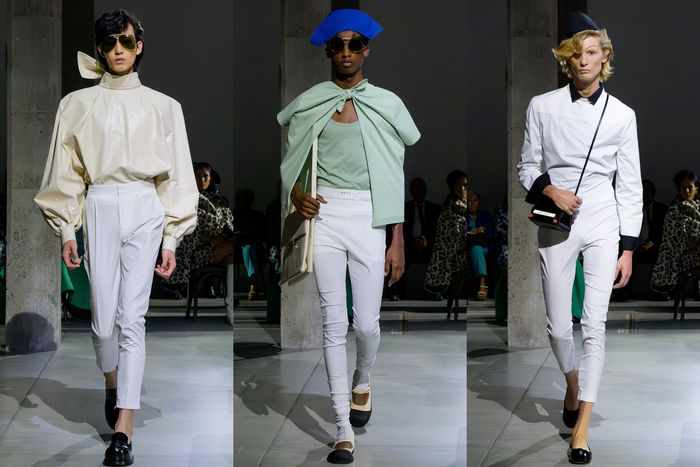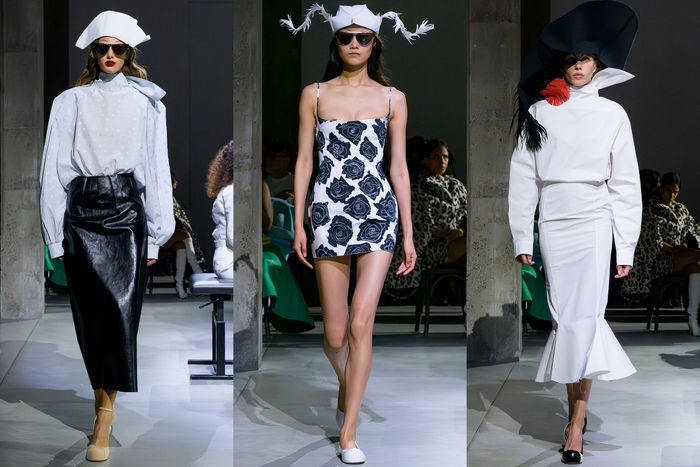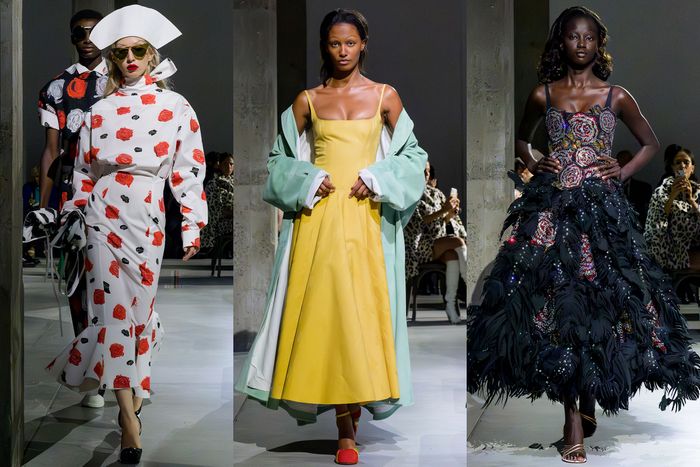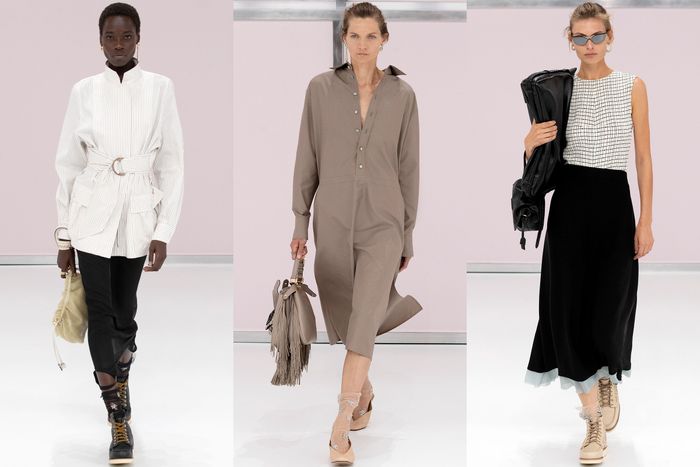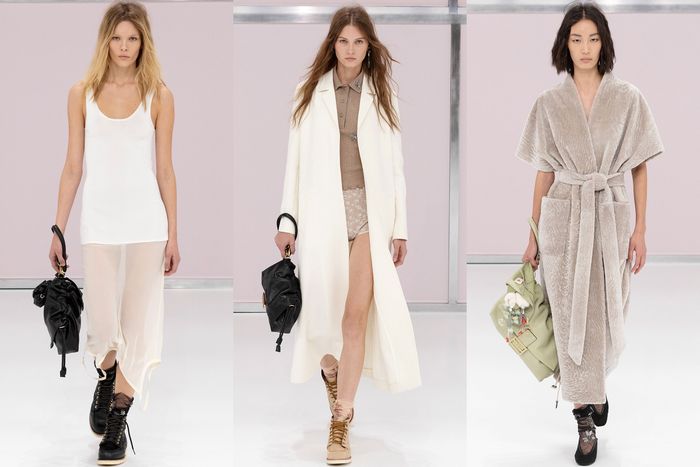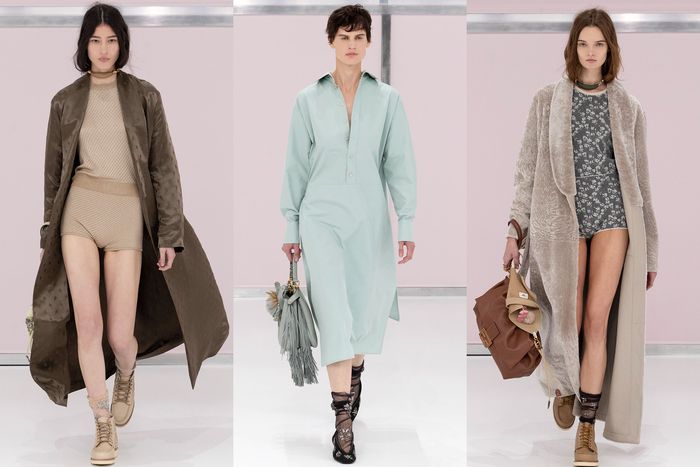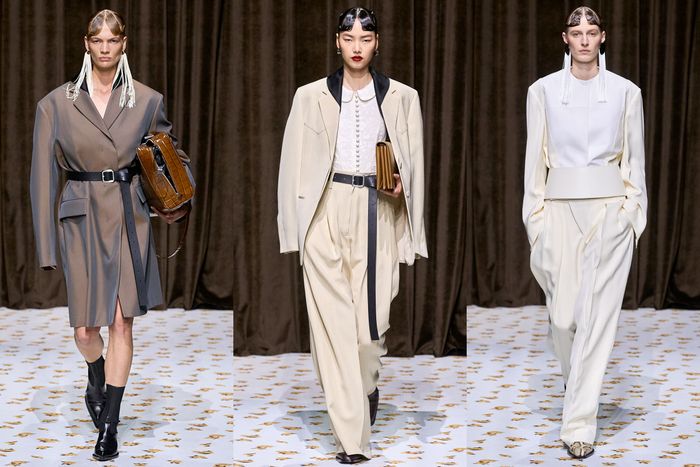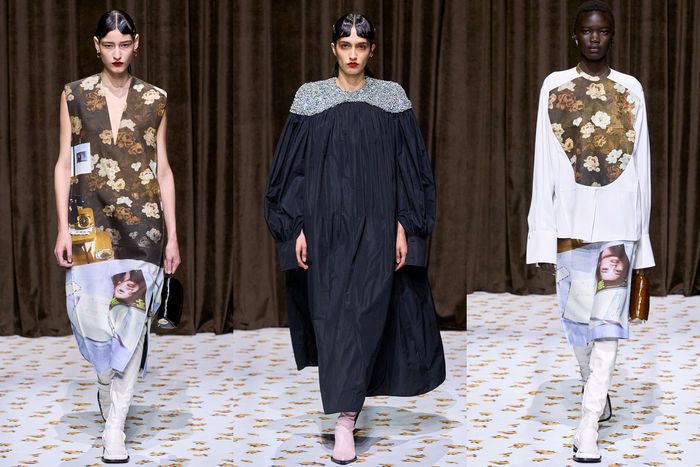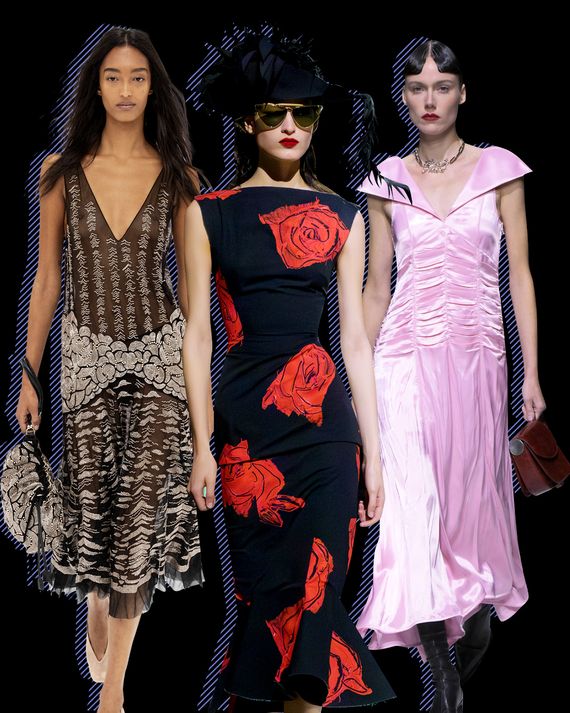
Photo-Illustration: by The Cut; Photos: Courtesy of Fendi, Marni, Jil Sander
You felt the change immediately in Milan: an awakening. Let’s make some beautiful clothes. London had good collections; New York, not so much. But on the first day of Milan, Kim Jones of Fendi and Francesco Risso of Marni reminded you that things can start again in fashion every six months, that your eye can suddenly change, and the old and tired can be driven out like the dictators.
Consider Risso’s set, in a sprawling room at Marni’s rustic headquarters, with wooden chairs arranged randomly, yet with clear pathways for the models to walk among the audience, to get close. Near the center were three grand pianos. Risso is a master of the communal, low-budget set. I’ve watched shows of his outdoors in Brooklyn, in a former factory in Milan, with guests perched on risers. There is often live music, always the work of Dev Hynes.
Yet when it comes to his fashion, Risso is a pure child, picking up one toy and putting it down for another that attracts his attention. In Brooklyn, in 2022, it was dynamic, body-revealing minimalism in sunrise colors. Last season, it was dark, almost futuristic shapes shown in a series of tunnels fully plastered with white paper. In between, in Paris, it was Francesco the Jolly Gardener, with minidresses made of cutout flowers, some in hand-painted metal.
Photo: Courtesy of Marni
On Tuesday, Risso returned to earth with a soulful, direct, and exceptionally timely show called Essential Beauty Routine. He merely meant dressing that followed a traditional form, from day to night, with the extra polish of makeup (exaggerated, pencil-thin eyebrows after Marlene Dietrich) and jaunty hats that looked homemade from paper and therefore chic. Far from being camp, though, the style was earnest. And that’s why it produced such a fresh charge, with Risso increasing the tempo as the show went on and the three pianists played an intense, at times chaotic score.
“This world now is so cruel, and so inhuman, that I think it’s good to maintain some form, to maintain extravagance,” Risso said, adding, “I keep thinking — is there anything more pure than the essence of beauty?”
Photo: Courtesy of Marni
That questioning led him to trim slacks of the 1960s-socialite genre with neat blazers or, say, a white cotton pullover with a black shirt (cuffs and collar exposed) with white slim pants and black flats. The beauty routine then shifted to pencil or trumpet skirts, including one with a high-collared smock top in what looked like leather, with a tie at the side of the neck. It was a great look. There were also long, dark-fitted coats in cotton with the white contrast of a trumpet skirt. Risso said virtually all the clothes were made of cotton, including the two final embellished numbers, with feathery or floral details.
Photo: Courtesy of Marni
It may have been Risso’s best collection in his nine years at Marni, certainly his most positive in terms of commerce. The collection offers a dozen or more entry points. When asked about the show’s repeated shapes or prints, Risso, as usual, had a ready answer.
“Repetition is like the Beatles,” he said. “You get better and better at it. That’s my mantra right now. I just want to learn.”
Photo: Courtesy of Fendi
Jones’s collection was far more subtle, refined, and personal, though maybe all of the English designer’s work, whether for Fendi or Dior Homme, is quietly personal. As he said, “London is for menswear, Paris is couture, and Milan is ready-to-wear. I’m looking at ways that really elevate ready-to-wear.”
He did that without a hammer. The opening sheer shifts with delicate Art Deco detailing were essentially big T-shirts — with work boots done in collaboration with Red Wing. Next year marks the centennial of two forces close to Jones’s heart — the founding of the house of Fendi, by Adele Fendi, and the publication of Mrs. Dalloway, the novel by Virginia Woolf. Jones is a vice-president of Charleston, the farmhouse and garden in East Sussex, England, that was the home of Woolf’s sister Vanessa Bell and her husband, Duncan Grant.
Photo: Courtesy of Fendi
“I was thinking of Mrs. Dalloway buying a new dress,” Jones said. That’s only one part of a story he was imagining. Many styles in this sensitive show expressed the character of different Fendi women across three generations. (A Fendi retrospective is planned for next year in Rome.) Looking at the clothes — a bisque-colored coat of brushed shearing, a slim, creamy white coat in rich linen, a white tank top with a sheer skirt, a silk dressing gown — I also saw costumes for a movie, a movie about a cultivated Italian family. There was a pair of cotton shirt dresses, in tan or aqua, that might be for the matriarch; a very cool and plush shearling robe-style coat over a knit T-shirt and boy shorts for a young member of the tribe.
Photo: Courtesy of Fendi
In addition to the 1920s slip dresses, my favorite look, though, was a pair of slim-line, patterned silk dresses worn with an apron of heavy white (or black) cotton. The apron wasn’t obvious from the front view of each dress. This domestic symbol was only clear once the model passed by. The idea was so simple and clever, and I’m sure it will be forgotten when the European shows end. Still, interesting fashion is often made from such discreet gestures.
Photo: Courtesy of Jil Sander
Sometimes a form needs to escape itself to find a new expression, and that’s precisely what Luke and Lucie Meier have done over the past few years at Jil Sander. They bent its minimalism, tried a different palette (as Raf Simons first did at Sander), and generally their methods worked, until the last couple of seasons. The designs started to look forced and weird — and not a good weird.
Photo: Courtesy of Jil Sander
I don’t know if the Meiers decided to dial things back, but their show on Wednesday came as a pleasant reprieve, not exactly a return to the roots of Jil Sander but certainly a direct expression of their minimalism. There were opening coats and pants suits, all in monochromes of year-round charcoal, tan, burgundy, and slate blue, followed by variations of simple but elegant shirts with wide-leg, masculine pants. The best was a cream-colored, round-neck top worn with matching pants and finished with what looked like a wide, loose belt in cream leather. Again, the T-shirt seemed to inspire straight-line tops with matching skirts in ombré pastels. The Meiers also included some familiar shapes, which I didn’t mind seeing again or a different form, like long cotton smocks in cream, peach, or black with beadwork encrusted on the shoulders. They showed a quite similar shape, with paisley details, two years ago.

